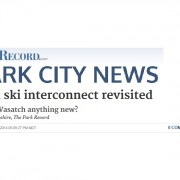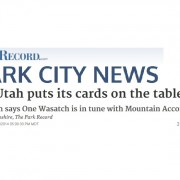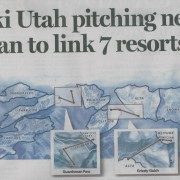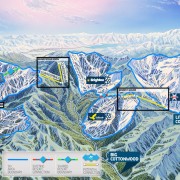Archive for month: September, 2014
Real Vail: Vail’s Park City/Canyons deal ushers in Era of the Interconnect
/in Recent News /by adminVail’s Park City/Canyons deal ushers in Era of the Interconnect
Today’s announcement of Vail Resorts’ $182.5 million deal to buy Powdr Corp’s Park City Mountain Resort and connect to its neighboring Canyons Resort gives a huge boost to Utah’s One Wasatch plan to connect seven ski areas accessed by one lift ticket.
Besides being the first link in the network, the Park City/Canyons connection alone will create a 7,000-acre-plus ski complex that will immediately rank as the largest in the United States once the lifts are in place by the 2015-16 ski season (pending government approvals).
But One Wasatch – a concept announced last spring by trade association Ski Utah and endorsed by all seven resorts – would create an 18,000-acre, 100-lift interconnected complex that would rank among the great ski networks in the world.
With six relatively simple lift connections, One Wasatch would link Park City/Canyons (more than 7,000 acres) and Deer Valley (2,026) in the Park City area to Brighton (1,050) and Solitude (1,200) in Big Cottonwood Canyon and Alta (2,200) and Snowbird (2,500) in Little Cottonwood Canyon.
Six of those seven resorts (excluding Canyons) are already part of the Ski Utah Interconnect, a guided $325 backcountry experience that can be done with standard alpine equipment. One Wasatch would add Canyons and connect all seven with lift access. No hiking necessary.
In fact, the seven ski areas mentioned are so close there’s very little hiking required now, as I discovered when I skied the Interconnect in 2006. Touring between ski resorts and ski towns is a uniquely European ski experience, and to some degree will stay that way even if One Wasatch comes to fruition, because Utah’s only real ski town on par with Breckenridge, Telluride, Aspen, Steamboat and Vail is Park City. Little and Big Cottonwood Canyons just contain ski areas.
Still, Utah will suddenly have a lot more to offer than “just” some of the best powder skiing on the planet. Besides serving up consistently deep snow a mere 35 to 40 minutes from Salt Lake City International Airport, the state will have a truly European-style interconnected alpine skiing experience that could make it a threat to Colorado’s skier-day dominance in the United States.
Since hosting the 2002 Winter Olympics, Utah has seen its skier days climb from 3 million to 4 million a season, but that still pales in comparison to Colorado’s 12 million skier days a season – by far the most in the nation. The One Wasatch concept is one that’s been around for decades.
If bigger is truly better, however, a combined Park City/Canyons complex and eventually the One Wasatch interconnect will give Utah something Colorado can’t compete with in terms of sheer acreage. The closest any Colorado resort can come to 7,300 acres is Vail’s 5,289, which makes it the largest single-mountain resort in North America.
The largest ski complex on the continent is Whistler/Blackcomb – linked by an incredibly soaring gondola — at 8,171 acres. Vail Resorts could come close in Colorado if it were to someday link Vail with Beaver Creek (1,818 acres) – a complex that would total 8,107 acres.
But that interconnect remains a distance fantasy of Vail’s founding fathers that would require a permitting miracle given the amount of public land involved, although at one point Vail did own the Meadow Mountain ski area (now a tubing hill) between the two resorts. Now it also contains the local Forest Service headquarters after Vail sold the property years ago. The town of Minturn also might have something to say about such a plan, although there are some advocates of a Minturn ski portal living in that funky old railroad town at the bottom of the Minturn Mile – a famous backcountry ski egress off Vail Mountain.
Environmentally speaking, I think lift-connected resorts make a lot of sense, removing cars from the roads and encouraging public transportation in general. Park your car for a week and get around on free shuttles and lifts. Better yet, take a shuttle from the airport and leave your car at home.
Telluride has just such a commuter gondola linking its truly classic ski town to the swanky real estate development of Mountain Village, and one resort complex in Colorado that could rival One Wasatch is Aspen.
Connect all four Aspen ski areas — Snowmass, (3,332 acres), Aspen Mountain, (675), Aspen Highlands (1,040) and Buttermilk (470) — and you’d have some of the best skiing on the planet linked up into a 5,517-acre complex. Of course, that’s still just a little bit bigger than Vail.
But an Aspen interconnect would be a game-changer in Colorado, allowing people to stay in Snowmass Village and ski over to the quintessential mining-town-turned-ski-town of Aspen and vice versa. That’s what’s really attractive about interconnects for the average tourist. It’s not so much the ski-terrain access as it is the ability to tour between ski towns, have lunch somewhere else and ski back.
There’s been talk of connecting some of the Aspen mountains in the past, such as Snowmass to tiny Buttermilk (site of the globally renowned Winter X Games) through Burnt Mountain, but that plan drew opposition from no less a luminary than ski mountaineer Lou Dawson.
Part of the charm of skiing in Europe is touring between quaint ski villages, wining, dining and touring back. A Vail-to Minturn-to-Beaver Creek-to-Edwards connection could achieve something like that in Colorado, but there would be huge opposition from environmentalists, some Minturn residents and backcountry skiers seeking to protect their private stashes.
From Vail’s Outer Mongolia Bowl you can see the slopes of Beaver Creek to the west and Copper Mountain to the east, but – unlike the Utah resorts – there are huge swaths of public land in between. Plus you now have the question of whether Vail Resorts and Powdr Corp. will ever be able to play nice again after months of bitter litigation at Park City.
Former Park City owner Powdr owns Copper, which sits between Vail and Vail Resorts’ Breckenridge ski complex. But the distances are so much greater than the Wasatch ski areas, and there’s the matter of all that public land in between in Colorado. It’s mostly all private in Utah.
That includes arguably the best skiing in the state at Alta/Snowbird, where expert skiers who like to hike will continue to congregate rather than the intermediate pitches of Park City, which fit so nicely into Vail’s quiver of big but relatively benign resorts like Vail, Breck, Keystone and Heavenly.
And Snowbird is now owned by the Cumming family, which also owns Powdr, so that’s another complicating factor in the One Wasatch equation. Ironically, Dick Bass, brother of former Vail owner Harry Bass, recently sold Snowbird to Ian Cumming.
If you’re a true expert skier, you don’t really go to Colorado to ski Vail or Utah to ski Park City or Lake Tahoe to ski Heavenly. You’re more likely to be drawn to Aspen, Crested Butte or Telluride in Colorado, Alta/Snowbird in Utah and Squaw Valley/Alpine Meadows in Tahoe.
Which brings me to another interconnect scenario involving another Colorado company, KSL Capital Partners. Lake Tahoe’s many resorts are in some cases closely grouped and ideal for Euro-style interconnects, but that’s especially true of KSL’s Squaw/Alpine complex, which no less of an industry expert than Warren Miller would like to see connected all the way to Homewood.
Right now Squaw Valley (3,600 acres) and Alpine Meadows (2,400) are side by side and can be skied in one day on one ticket, but the interconnect is less than ideal. That could change in just a few years if a deal can be worked out with the private resort of White Wolf in between the two.
Locals there are pumped about what would then be the largest interconnected ski complex in the United States at more than 6,000 skiable acres, but with the Park City deal now in the books, they’ll ultimately have to settle for second best in the U.S. and third in North America.
Regardless, it’s clear that with no new ski areas being built in the last couple of decades and none on the horizon, we’ve boldly entered into the Era of the Interconnect.
Link: http://goo.gl/LzCyU0
Park Record: Utah ski interconnect revisited
/in Recent News /by adminIs ONE Wasatch anything new?
David Hampshire, The Park Record – Posted: 09/09/2014 05:09:27 PM MDT
The glaciers may be on their way out, but some things [besides Congress] still move at a glacial pace.
A few years back, Raivo Puusemp, one of Nathan Rafferty’s predecessors as president of Ski Utah, told this reporter about the Utah Ski Interconnect, a plan to link Park City with Brighton, Solitude, Alta and Snowbird.
“Nationwide, this is the biggest thing in skiing since the first chairlift at Sun Valley,” Puusemp said with a touch of hyperbole. “Everybody is jumping on it.”
Actually, it was more than a few years back. It was the fall of 1982. And the concept wasn’t new even then. It had been kicked around since the early days of Treasure Mountains, now Park City Mountain Resort.
In October 1988, SKI Magazine revisited the Interconnect proposal.
“The ambitious Interconnect plan is currently on hold in the wake of Salt Lake County’s decision to formulate a master plan to decide the future of the seven canyons which make up the Wasatch Front and hold most of Utah’s famous ski resorts,” the magazine reported.
The story continued with this quote from Ralph Becker of Bear West, the consulting firm hired to oversee the master-plan process: “The Interconnect, ski traffic, ski area expansion and whether or not to pursue an Olympic bid are all major areas of concern.”
Becker is now the mayor of Salt Lake City and the Olympics have come and gone. But, as for those other issues, well, isn’t that what Mountain Accord is still talking about now?
Puusemp’s plan included only one local mountain, Park City Mountain Resort, then known as Park City Ski Area.
Canyons Resort, then known as ParkWest, was considered too small and too isolated to deserve inclusion. And the ownership of Deer Valley, in just its second year of operation, was being deliberately noncommittal.
“I think the concept is just great,” said John Miiller, then executive vice president of Deer Valley. “But there are a lot of unanswered questions about Ski Interconnect. There’s ownership of land, and who’s going to build what, and how the ticket system works, and so on and so forth.”
[Reporter's note: Yes, there are two "i"s in Miiller and two "u"s in Puusemp, which might have caused spell check to crash had there been such a thing in 1982.]
Miiller didn’t mention snowboards back then, because they weren’t an issue. In 1982 only one U.S. resort Vermont’s Suicide Six allowed Jake Burton’s new gadget on its slopes, according to www.burton.com. But they’re an issue now, with Alta and Deer Valley among three U.S. resorts that still keep boarders on the sidelines.
Bob Wheaton, now the president and general manager at Deer Valley, said One Wasatch already has a template for settling the snowboard issue. He pointed that Alta and Snowbird already sell an “AltaBird” pass that’s honored at both resorts only if you’re on skis. If you’re on a snowboard, you stay at Snowbird.
“They already have that figured out and have been doing that for a number of years now,” he said.
And, Wheaton added, several issues ticketing, for example — have been resolved in the intervening years.
“I think it (ONE Wasatch) is feasible in a shorter time than people think because some of the issues have been thought through already,” he said.
In last week’s appearance at the Summit County Council meeting, Rafferty noted that the resorts aren’t as far apart physically as they once were.
“They’ve really grown in proximity, closer and closer together over the years, and I think that’s a big reason why this concept is coming to fruition now.”
For more about ONE Wasatch, check out David Hampshire’s accompanying story, “Ski Utah puts its cards on the table.”
http://www.parkrecord.com/park_city-news/ci_26500399/utah-ski-interconnect-revisited
AP: Details emerge on plan to link 7 Utah ski resorts
/in Recent News /by adminDetails emerge on plan to link 7 Utah ski resorts
September 9, 2014
SALT LAKE CITY (AP) — Utah ski officials said Tuesday they’ve chosen two spots for lifts that would be lynchpins in an ambitious long-term plan to link seven ski areas that would give the state a European-style experience.
The new details mark another small step forward in a project that is likely many years away from coming to fruition. Executives from seven ski resorts committed to the project in April after decades of discussion.
One lift would be in Grizzly Gulch and connect Solitude Mountain Resort in the Big Cottonwood Canyon to Alta Ski Area in the Little Cottonwood Canyon, Ski Utah announced. The other would be at Guardsman Pass and link Park City Mountain Resort to Brighton Resort in the Big Cottonwood.
The project remains in the conceptual phase with the latest announcement intended to illicit feedback and create excitement, said Nathan Rafferty, president of Ski Utah, a trade organization spearheading the project.
“We just want to be deliberate and thoughtful in how this rolls out,” Rafferty said, while adding, “It’s an exciting and fun step for our industry here in Utah.”
The project is expected to cost up to $30 million, paid for entirely by the resorts. No timetable has been set for work.
It would link Alta Ski Area, Brighton Resort, Canyons Resort, Deer Valley Resort, Park City Mountain Resort, Snowbird Ski Resort and Solitude Mountain Resort. Skiers who buy one pass would have access to 100 lifts, 750 ski runs and more than 18,000 skiable acres.
By combining 25 square miles of terrain, the Utah resorts could offer North America’s largest skiing complex — three times the size of Vail, Colorado and twice as big as Whistler Blackcomb in British Columbia.
It would create an experience unique to North America. In Europe, lifts connecting ski areas are common. In the U.S., a daily pass to a ski resort usually confines you to that resort no matter how close a neighboring resort is.
The project, which is being called “One Wasatch,” is opposed by backcountry skiers and wilderness advocates who say more buildup will damage pristine areas used by outdoor enthusiasts and harm the watershed.
The new details did nothing to alleviate their concerns. The project is a marketing ploy to bring more skiers to the state at the expense of hikers, backcountry skiers, snowshoers and wildlife photographers who would be negatively affected, said Alex Schmidt, campaign coordinator of Save Our Canyons.
“We want to preserve this area for its wild qualities,” Schmidt said.
Rafferty is aware of the concerns and said they are working with all groups. He said the ski resorts have long been good stewards of the watershed, and emphasized that it’s not impossible to link the resorts while protecting the environment and backcountry.
“While it does take some new terrain to make these connections possible, I don’t think it irreparably damages our unrivaled backcountry experience,” Rafferty said.
The two spots chosen for connecting points were picked by ski area officials who know the terrain best as the most efficient spots, Rafferty said. But, with the project in its infancy stages, they remain open to suggestions, he said.
A third connecting point needs to be selected to link Canyons Resort and Park City Mountain Resort, Rafferty said. Such plans have been delayed as long-running legal battle involving the resorts plays out, he said.
The upcoming ski season is set to begin in Utah in about two months.
Copyright © The Associated Press. All rights reserved. This material may not be published, broadcast, rewritten or redistributed.
Park Record: Ski Utah puts its cards on the table
/in Recent News /by adminSki Utah says ONE Wasatch is in tune with Mountain Accord
David Hampshire, The Park Record
Posted: 09/09/2014 05:09:30 PM MDT
On one hand there’s Mountain Accord, an effort by various entities to chart the future of the Wasatch Range, with a focus on the environment, recreation, transportation and the economy.
On the other hand there’s One Wasatch, a proposal by a ski industry group to connect seven Wasatch Front ski resorts into one huge alpine playground with 100 chairlifts and more than 700 runs on 18,000 skiable acres.
So is One Wasatch an attempt to preempt the Mountain Accord planning process,
as the Utah Chapter of the Sierra Club charged in a recent online newsletter?
Nathan Rafferty, president of Ski Utah, which represents 14 Utah alpine resorts, defended the timing of the One Wasatch “concept” (his word) last week in a meeting of the Summit County Council at Kimball Junction.
“I think One Wasatch — when you really start putting lines on a map and understanding who wants to be where and how many people we can allow in one spot or another — they (Mountain Accord) needed to know the full story about what the resorts want to do and what their future expansion plans are,” Rafferty said in response to a question from Council Chairman Chris Robinson.
“And if you’re going to put any kind of transportation solution into and out of these mountains, it makes sense to know where the ski runs might go.”
However, Rafferty was careful to point out that One Wasatch is not designed as a transportation solution. “This is a ski experience. (But) I think there are transportation efficiencies, for sure.
Originally unveiled at a March 19, 2014, press conference in Salt Lake City, One Wasatch proposes to link Canyons, Park City Mountain Resort, Deer Valley, Brighton, Solitude, Alta and Snowbird with six strategically placed lifts. Rafferty noted last week that general managers from all seven resorts were present at that meeting.
“I think we do a really, really good job of cooperating between the ski areas. And I say that, and it’s kind of ironic to say that today and this week with what’s going on with Park City and Canyons. But outside of the courtroom and what goes on there, our GMs all sit together at our board meetings.”
Rafferty said after last week’s meeting that One Wasatch has no connection with the SkiLink proposal to build a lift between Solitude and Canyons.
“What makes this different is that this would connect the Park City area to Big and Little Cottonwood Canyon, but it would be on private land, which is a very different deal than SkiLink, which was on public land,” he said.
Linking the seven Utah resorts would create the largest ski area in North America, Rafferty told the county council.
“The next largest in North America is Whistler/Blackcomb (in British Columbia) those are two ski areas that were merged and they ski 8,000 acres between the two,” he said.
“As big as that is in North America, it’s really not much compared to Europe. The Trois Vallées in France is over 55,000 acres. Again, it’s tough to make an apples-to-apples comparison because they measure their skiing a little bit differently But this would be as close to kind of a European ski experience.”
According to Ski Utah statistics, skiers and snowboarders spend about $1.3 billion in the state each year, of which about $1.1 billion comes from out-of-state visitors. He portrayed the One Wasatch concept as a way to help Utah keep pace with its three major competitors in alpine skiing: Colorado, California and Vermont.
County Manager Bob Jasper wondered whether Sundance Resort is too far away to be a part of One Wasatch.
“Yeah, right now,” Rafferty said. “It would be a long, expensive lift. And I’m not speaking for Sundance, but they’ve got a really nice brand, and I’m not sure they want to throw a line out our way yet.”
Robinson said Ski Utah has done an excellent job of getting its wish list out on the table.
“I think it’s an example of Ski Utah knowing what it wants,” he said. “Does Summit County know what it wants? Does Park City know what it wants? You guys have figured it out and you’re ahead of the game. We’re trying to figure it out as to what’s right for us, for the communities.”
For more about One Wasatch, check out David Hampshire’s accompanying story, “Utah ski interconnect revisited.”
http://www.parkrecord.com/park_city-news/ci_26500400/ski-utah-puts-its-cards-table
Salt Lake Tribune: Ski Utah Pitching New Plan to Link 7 Resorts
/in Recent News /by adminSalt Lake Tribune: Ski Utah Pitching New Plan to Link 7 Resorts
By Mike Gorrell – Published: September 9, 2014 10:28AM
Ski Utah is offering a few more details about where lifts would be needed to make One Wasatch, its plan for interconnecting the seven Wasatch Mountain ski resorts, a reality.
Two sets of lifts are envisioned in a conceptual plan to be released Tuesday, said Nathan Rafferty, president and CEO of Ski Utah, marketing arm for the state’s ski industry.
The first set, connecting Little Cottonwood and Big Cottonwood canyons, would require Alta Ski Area to install a lift up Grizzly Gulch to the ridgeline, where it would hook up with a lift coming up Honeycomb Canyon from Solitude Mountain Resort.
The connection between Big Cottonwood and the Park City side of the Wasatch would take place in the Guardsman Pass area. One lift would make it possible for riders coming from Brighton’s Great Western lift to reach Park City Mountain Resort, while the other would help transport skiers and snowboarders from PCMR’s Jupiter Bowl area over to Brighton.
This latest plan does away with the proposed Ski Link hookup between Solitude and Canyons Resort.
Conservationists and backcountry skiers reviled Ski Link as a precursor to the interconnect plan, in part because it opened up hard-to-access terrain to people riding lifts. But Ski Link has been on the backburner for more than a year, ever since Canyons Resort turned its attention instead to acquiring PCMR.
Because of the unresolved litigation in that fight, the new design does not address a connection between Canyons and PCMR, physically the easiest to do. No connection may be necessary if Canyons prevails in that lawsuit.
A 3rd District judge gave PCMR until Friday to post a $17.5 million bond that would keep the resort going through the upcoming season while PCMR appeals an earlier ruling upholding Canyons’ ability to evict it for failing to renew a mountainside lease on time.
The other three connections — between Deer Valley and PCMR, Brighton and Solitude, and Alta and Snowbird — already are in place.
“Connecting seven of Utah’s finest ski resorts while preserving both our water quality and an unrivaled backcountry task is not an impossible task,” Rafferty said Monday.
“We have decided to move a step forward in the vision process by conceptualizing lift alignments on a map to continue providing information to the public, encouraging dialogue and listening to feedback about these possible connections,” he added, noting that a Ski Utah survey also showed solid public support for the interconnect idea.
Ski Utah sent a short survey to 35,000 online subscribers to its monthly newsletter or daily snow reports, receiving more than 3,000 back. Of those, 45 percent think an interconnect is a great idea, while another 28 percent said it was somewhat good. About 19 percent of respondents thought One Wasatch was a somewhat or very bad idea.
Neither the lift alignments nor the survey results surprised Save Our Canyons Executive Director Carl Fisher, nor did they diminish his objections to the concept.
“If we did a poll of our membership, we would find that 90 percent want to see wilderness expanded through the Wasatch Mountains,” he said. “Polls aren’t very conclusive when you’re not polling an objective portion of the community.”
Fisher said the lift alignments around Guardsman Pass and between the Cottonwood canyons were relatively easy to predict. The most troublesome part to him involves Alta’s plan for Grizzly Gulch, which he believes would require an amendment to the U.S. Forest Service master plan.
“That is not something we would support at all,” Fisher said. “The plan says the ski resorts in their existing configuration is adequate. We agree with that.”
At present, the Grizzly Gulch lift is contemplated to go over a parcel of Forest Service property that is not part of Alta’s special use permit, which would require extra environmental analysis.
That doesn’t concern Alta General Manager Onno Wieringa, noting he has spent years talking to the Forest Service about Grizzly Gulch’s potential and challenges.
“The Forest Service likes us to do what makes the most sense, to have the best alignment that works for the best of the people and not to do convoluted things,” Wieringa said. “This makes the best sense to us. We’ll see if we can work something out with the Forest Service.”
He likes Rafferty’s plan to submit the concept to Mountain Accord, a broad-based public and private effort trying to determine how best to treat the popular central Wasatch Mountains in a more heavily populated future.
“They have so many people involved and they’re really good at getting people to put their cards on the table and say ‘this is what we’re thinking.’ I would like to think that the recommendations [Mountain Accord] comes up with will be looked at by the Forest Service as a good public process,” Wieringa said.
Fisher also thinks Mountain Accord is a good forum to vet interconnect issues.
“It’s certainly more inclusive, definitely a more robust process,” he said. “Mountain Accord has its issues. It’s trying to bite off a whole lot and it’s a little overwhelming. But it’s a pretty good venue.”
No timetable has been set for development, Rafferty said.
mikeg@sltrib.com
Twitter: @sltribmikeg
http://www.sltrib.com/sltrib/politics/58389385-90/ski-lift-canyons-plan.html.csp
Ski Utah and Area Resorts Unveil ONE Wasatch Conceptual Lift Alignment Locations & New Survey Results Released
/in The Blog /by admin(SALT LAKE CITY, UTAH) – Today, Ski Utah along with seven ski resort mangers released a new map detailing lift alignments of two of the three potential connections for an over-the-snow interconnect between all seven resorts via chairlift and ski run called ONE Wasatch. ONE Wasatch would offer the largest lift-served ski experience in North America – over 18,000 acres, 100 lifts and more than 750 runs, all on one pass. And all on “The Greatest Snow on Earth.”
The two lift alignments are located on the attached map and include:
- Solitude (Big Cottonwood) to/from Alta (Little Cottonwood)
- Park City Mountain Resort (Summit County) to/from Brighton (Big Cottonwood)
The third connection between Canyons Resort to/from Park City Mountain Resort will be determined at a later date.
“Connecting seven of Utah’s finest ski resorts while preserving both our water quality and an unrivaled backcountry experience is not an impossible task,” said Nathan Rafferty, president and CEO – Ski Utah. “Today we have decided to move a step forward in the vision process by conceptualizing lift alignments on a map to continue providing information to the public, encouraging dialog and listening to feedback about these potential connections.”
In addition to the release of the map, Ski Utah shared results of a survey they conducted about the ONE Wasatch concept. The survey was sent to more than 35,000 individual online subscribers of their monthly newsletter and snow reports. Since the respondents cover all types of recreationists that follow snow/skiing and riding conditions, we can infer they include both downhill as well as backcountry users. The following summarizes a review of the responses.
Of the 35,468 survey requests, 3,009 completed the survey—a response rate of almost 9 percent.
- A high number—77% of the respondents—have heard of ONE Wasatch.
- Of those that have heard of the concept, 73% of the overall respondents believed the concept was a somewhat or very good idea, while only 19% thought that it was a somewhat or very bad idea; 8% were not sure (nearly 4 to 1 margin of favorable vs unfavorable responses)
- The respondents, by an overwhelming margin, indicated they would use ONE Wasatch once it was completed–71% said they were somewhat or very likely to use it, compared to 25% that said they were somewhat or not very likely to use it (almost 3 to 1 in favor).
For more information regarding ONE Wasatch please visit our website at www.ONEWasatch.com.
For media information, contact Ski Utah Director of Communications Susie English at 801.433.2016 or by email at susie@skiutah.com.
###
Ski Utah is the marketing firm owned and operated by the 15 statewide ski resorts that make up the Utah Ski and Snowboard Association. The organization has been creating brand awareness of and demand for the Utah wintersports product since its inception in 1978. Ski Utah’s primary functions are concentrated in marketing, public policy and public relations. Information about Ski Utah and its members can be found at skiutah.com, on Twitter and Instagram @SkiUtah and on Facebook at www.facebook.com/skiutahyeti. This release and other press information can be found in the online press room at /News/.







